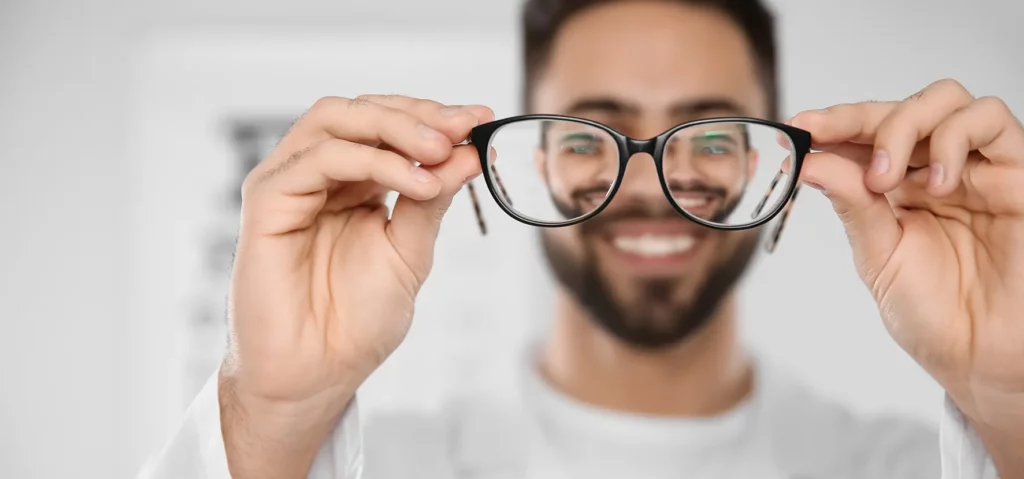In today’s fast-paced world, visual acuity plays a vital role in our daily lives. For individuals with high myopia, or severe nearsightedness, simple tasks like reading a signpost or recognizing faces can become challenging without corrective measures. But here’s a solution! In this blog, we will explore the benefits, procedure, recovery process, and potential risks associated with PRK for high myopia. If you or someone you know is considering this treatment option, read on to discover more about this life-changing procedure.
Contents
Understanding The Causes Of High Myopia
 High myopia, also known as severe nearsightedness, is a refractive error that affects a significant number of individuals worldwide. Unlike mild to moderate myopia, high myopia is characterized by a more pronounced and extreme difficulty in seeing distant objects clearly.
High myopia, also known as severe nearsightedness, is a refractive error that affects a significant number of individuals worldwide. Unlike mild to moderate myopia, high myopia is characterized by a more pronounced and extreme difficulty in seeing distant objects clearly.
High myopia is primarily caused by an elongated eyeball or a steep cornea curvature. These structural abnormalities result in light rays focusing in front of the retina instead of directly on it, leading to blurred distance vision. While the exact causes of high myopia are not fully understood, it is believed to be influenced by both genetic and environmental factors. If you have a family history of high myopia, you may be at a higher risk of developing the condition.
Symptoms of High Myopia
Individuals with high myopia commonly experience the following symptoms:
- Blurry distance vision: Objects in the distance appear blurred and lack sharpness.
- Squinting: Straining the eyes or squinting to see clearly is a common reflex for those with high myopia.
- Difficulty in low-light conditions: High myopia can cause challenges in seeing clearly in dimly lit environments.
- Eye fatigue: Prolonged focusing on near objects can lead to eye strain and fatigue.
- Headaches: Eye strain can trigger frequent headaches, especially after prolonged visual tasks.
- Reduced depth perception: High myopia may affect depth perception, making activities like driving or playing sports more challenging.
Implications of High Myopia
If left uncorrected, high myopia can have various implications on visual health. Individuals with high myopia are at an increased risk of developing complications such as:
- Retinal detachment: The elongated shape of the eyeball can increase the likelihood of the retina detaching from its underlying tissue, which requires immediate medical attention.
- Myopic macular degeneration: High myopia can lead to the development of macular degeneration, a condition that affects the central part of the retina responsible for sharp vision.
- Glaucoma: Individuals with high myopia have a higher risk of developing glaucoma, a progressive eye disease that damages the optic nerve and can lead to vision loss.
Exploring PRK and How Can it Cure High Myopia?
 Photorefractive Keratectomy (PRK) is a popular and effective surgical procedure used to correct refractive errors, including high myopia. PRK addresses high myopia by flattening the cornea’s curvature in a controlled manner. By reshaping the cornea, the procedure allows light rays to focus precisely onto the retina, eliminating the need for glasses or contact lenses for distance vision. Below we’ll explore how PRK cures high myopia through its effective procedure.
Photorefractive Keratectomy (PRK) is a popular and effective surgical procedure used to correct refractive errors, including high myopia. PRK addresses high myopia by flattening the cornea’s curvature in a controlled manner. By reshaping the cornea, the procedure allows light rays to focus precisely onto the retina, eliminating the need for glasses or contact lenses for distance vision. Below we’ll explore how PRK cures high myopia through its effective procedure.
The PRK Procedure
- Preparation: Prior to the procedure, the eye is numbed with eye drops, and the surgeon may place a speculum to keep the eyelids open.
- Epithelial Removal: The surgeon gently removes the thin layer of epithelial cells from the cornea’s surface using a specialized brush or laser.
- Laser Reshaping: An excimer laser is then used to precisely reshape the cornea by removing microscopic amounts of tissue. The laser operates based on a computer-guided pattern, customized to the individual’s specific prescription.
- Protective Contact Lens: After the cornea is reshaped, a soft contact lens may be placed on the eye to protect the newly treated surface during the initial healing phase.
Is PRK Safe for High Myopia?
When considering any surgical procedure, it is essential to understand the safety aspects associated with the treatment. PRK has been performed for several decades and has a proven track record of safety and efficacy. The reasons include:
- It has undergone extensive research, development, and refinement over the years, resulting in improved techniques and outcomes.
- The procedure has been approved by regulatory authorities and is performed by trained ophthalmologists in controlled surgical environments.
- To determine if PRK is suitable for high myopia correction, a thorough preoperative evaluation is conducted. This evaluation helps identify any potential contraindications or factors that may increase the risks associated with PRK.
- Choosing an experienced and qualified ophthalmologist to perform the PRK procedure is crucial for safety and optimal outcomes.
What is the Maximum Myopia for PRK?
The maximum myopia that can be effectively treated with PRK varies depending on several factors, including the individual’s corneal thickness and overall eye health. Generally, PRK can effectively correct myopia up to approximately -8.00 to -12.00 diopters. However, there are a few factors to consider:
- Corneal Thickness Consideration
Corneal thickness plays a crucial role in determining maximum myopia that can be treated with PRK. If the cornea is too thin, removing excess tissue may compromise its structural integrity and pose a risk to the overall health and stability of the eye. - Evaluation and Individualized Treatment
To determine the maximum myopia that can be safely corrected with PRK, a comprehensive evaluation is conducted by an ophthalmologist. Based on these assessments, the ophthalmologist can determine the appropriate treatment plan and whether PRK is a suitable option for the individual’s specific case. - Alternative Treatment Options
In cases where the degree of myopia exceeds the limits for PRK, alternative treatment options may be considered. One common alternative is LASIK, a procedure that involves creating a thin corneal flap before reshaping the underlying tissue with a laser. LASIK can treat higher degrees of myopia due to the preservation of a thicker corneal bed.
What to Expect After PRK Surgery
 After undergoing Photorefractive Keratectomy (PRK) surgery for the correction of high myopia, it is important to understand what to expect during the postoperative phase. PRK recovery involves a healing process that gradually improves vision over time. Here are the common experiences and guidelines to help you navigate the post-PRK period smoothly.
After undergoing Photorefractive Keratectomy (PRK) surgery for the correction of high myopia, it is important to understand what to expect during the postoperative phase. PRK recovery involves a healing process that gradually improves vision over time. Here are the common experiences and guidelines to help you navigate the post-PRK period smoothly.
Blurred Vision and Sensitivity
Immediately after PRK surgery, it is normal to experience blurry vision, glare, and light sensitivity. The cornea needs time to heal and adjust to its new shape, so it may take a few days or even weeks for your vision to stabilize. During this period, it is recommended to rest your eyes, avoid bright lights, and protect them from irritants such as dust or wind.
Discomfort and Eye Irritation
Mild to moderate discomfort and eye irritation are common after PRK surgery. You may experience a gritty or foreign body sensation, tearing, itching, or a feeling of dryness. These symptoms typically improve over time as the epithelium regenerates and the cornea heals. Your doctor may prescribe lubricating eye drops or ointments to alleviate discomfort and promote healing.
Visual Fluctuations
In the weeks following PRK, it is normal for your vision to fluctuate. Some days you may notice sharper vision, while on others it may be slightly blurry. This is part of the healing process as the cornea stabilizes and the visual acuity gradually improves. It is important to be patient and avoid making any conclusions about the final outcome until the healing period is complete.
Follow-up Visits
Your ophthalmologist will schedule regular follow-up visits to monitor your progress and ensure proper healing. These visits allow your doctor to assess your vision, evaluate the stability of the cornea, and make any necessary adjustments to your postoperative care. It is important to attend all scheduled appointments and communicate any concerns or changes in your symptoms to your doctor.
Timeframe for Vision Improvement
While each individual’s healing process is unique, most people experience significant visual improvement within the first few weeks after PRK surgery. However, achieving optimal visual acuity may take several months. It is essential to be patient and follow your doctor’s instructions regarding the use of eye drops, protective eyewear, and avoiding activities that may hinder the healing process.
Resuming Normal Activities
Your doctor will provide specific guidelines regarding when you can resume normal activities such as driving, exercising, and wearing makeup. It is crucial to adhere to these recommendations to prevent any complications and ensure a successful recovery. Avoid swimming, hot tubs, and contact sports until your doctor gives you clearance.
Long-term Care
Even after your vision has stabilized and you have achieved the desired results, it is important to maintain long-term eye care. Attend regular eye exams to monitor your eye health and vision. Protect your eyes from harmful UV rays by wearing sunglasses outdoors, and follow good hygiene practices to prevent eye infections.
Conclusion
When high myopia affects your daily life and hinders your visual experiences, PRK can offer a transformative solution. PRK offers an excellent option for achieving clearer vision and reducing dependence on glasses or contact lenses. However, in cases where PRK may not be suitable due to higher degrees of myopia, alternative treatments like LASIK can be explored.
Lasik surgery is a safe 10-minute procedure to help you get rid of glasses. EyeMantra offers the most advanced LASIK options including PRK, Femto Lasik, SMILE surgery, Standard LASIK, ICL, and Contoura vision. If you have any questions on Lasik surgery in Delhi, Lasik surgery cost, and Lasik procedure, call us at 9711116605 or email at [email protected]


